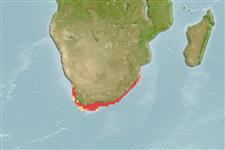>
Pleuronectiformes (Flatfishes) >
Soleidae (Soles)
Etymology: Austroglossus: Composed from Austro = the south + Greek, glossa = tongue (Ref. 45335).
More on author: Kaup.
Environment: milieu / climate zone / depth range / distribution range
Ecologia
marinhas demersal; intervalo de profundidade 10 - 400 m (Ref. 5304), usually 10 - 120 m (Ref. 3200). Subtropical; 25°S - 36°S, 17°E - 33°E
Southeast Atlantic: known only from the Cape to Natal in South Africa.
Tamanho / Peso / Idade
Maturity: Lm ? range ? - ? cm
Max length : 60.0 cm TL macho/indeterminado; (Ref. 3505); common length : 40.0 cm TL macho/indeterminado; (Ref. )
Descrição breve
Chaves de identificação | Morfologia | Morfometria
Espinhos dorsais (total) : 0; Raios dorsais moles (total) : 90 - 110; Espinhos anais: 0; Raios anais moles: 80 - 95; Vértebras: 58. Brownish, small dark spot at base of each scale; right pectoral fin blackish (Ref. 3200).
Inhabits mud bottoms (Ref. 27121). Feeds on small benthic invertebrates and small fish (Ref. 27121).
Life cycle and mating behavior
Maturidade | Reprodução | Desova | Ovos | Fecundidade | Larvas
Heemstra, P.C. and O. Gon, 1986. Soleidae. p. 868-874. In M.M. Smith and P.C. Heemstra (eds.) Smiths' sea fishes. Springer-Verlag, Berlin. (Ref. 3200)
Categoria na Lista Vermelha da IUCN (Ref. 130435: Version 2024-1)
Ameaça para o homem
Harmless
Utilização humana
Pescarias: pouco comercial
Ferramentas
Relatórios especiais
Descarregue XML
Fontes da internet
Estimates based on models
Preferred temperature (Ref.
123201): 13.2 - 26.4, mean 19.7 °C (based on 196 cells).
Phylogenetic diversity index (Ref.
82804): PD
50 = 0.7500 [Uniqueness, from 0.5 = low to 2.0 = high].
Bayesian length-weight: a=0.00501 (0.00298 - 0.00842), b=3.05 (2.91 - 3.19), in cm total length, based on LWR estimates for this species & (Sub)family-body (Ref.
93245).
Nível Trófico (Ref.
69278): 4.0 ±0.63 se; based on food items.
Generation time: 3.2 ( na - na) years. Estimated as median ln(3)/K based on 2
growth studies.
Resiliência (Ref.
120179): Médio, tempo mínimo de duplicação da população 1,4 - 4,4 anos (K=0.34-0.38).
Prior r = 0.25, 95% CL = 0.16 - 0.37, Based on 1 data-limited stock assessment.
Fishing Vulnerability (Ref.
59153): Low to moderate vulnerability (33 of 100).
Climate Vulnerability (Ref.
125649): Moderate to high vulnerability (49 of 100).
Nutrients (Ref.
124155): Calcium = 80.6 [27.5, 176.1] mg/100g; Iron = 0.925 [0.378, 1.973] mg/100g; Protein = 18.8 [16.9, 20.7] %; Omega3 = 0.204 [0.107, 0.376] g/100g; Selenium = 41.5 [19.8, 96.5] μg/100g; VitaminA = 6.08 [1.54, 24.04] μg/100g; Zinc = 0.477 [0.301, 0.736] mg/100g (wet weight);
